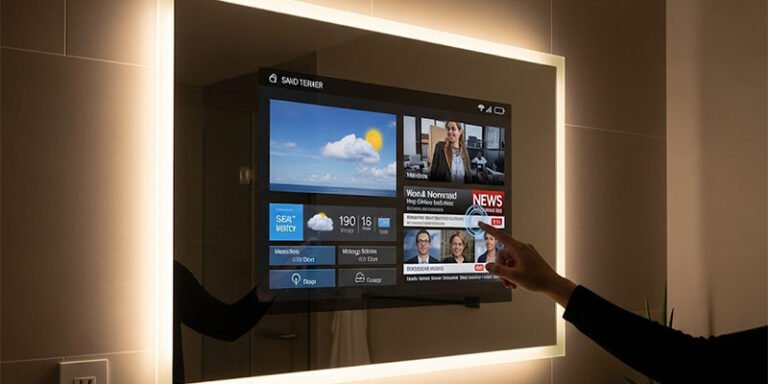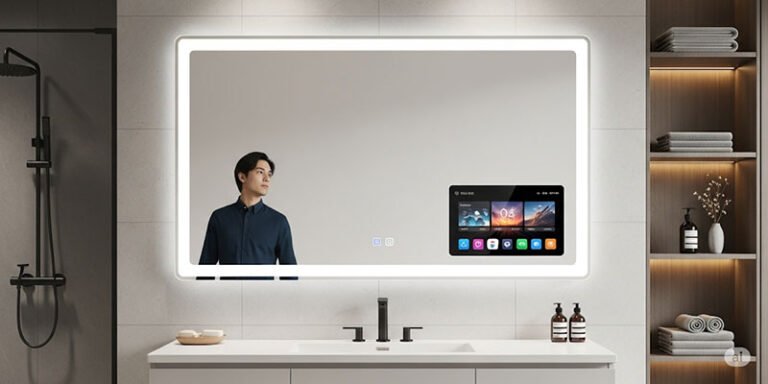Smart mirrors have moved from science fiction to reality, becoming a real option for modern homes. These devices combine a regular mirror with digital technology to display information like weather, news, and fitness data. Smart mirrors offer useful features like personalized information and smart home control, but they come with high costs and privacy concerns that buyers should consider.
The technology behind smart mirrors continues to improve in 2025. They can connect to other smart devices, play music, and even help with daily routines. Many people find them helpful for getting ready in the morning or staying updated on important information.
Understanding both the benefits and drawbacks helps determine if a smart mirror fits your needs and budget. The decision depends on your lifestyle, tech comfort level, and willingness to invest in connected home devices.
Key Takeaways
- Smart mirrors combine reflection with digital displays to show weather, news, and other personalized information
- Benefits include convenience and smart home integration, while drawbacks involve high costs and privacy risks
- Success with smart mirrors depends on matching their features to your daily routine and tech preferences
Understanding Smart Mirrors: Features and Technology
Smart mirrors combine traditional reflective glass with digital displays and interactive technology. These devices connect to wi-fi networks and integrate with smart home devices to deliver personalized experiences through voice control and touch interfaces.
What Is a Smart Mirror?
A smart mirror is a two-way mirror with a built-in display screen behind the reflective surface. The mirror shows both your reflection and digital information at the same time.
These devices use special glass that lets light pass through from behind. When the display is on, users can see text, images, and videos overlaid on their reflection.
Smart mirrors come in different sizes and styles. Some mount on walls like regular mirrors. Others sit on countertops or attach to existing mirrors.
The technology works by placing an LCD or LED screen behind partially reflective glass. The screen displays information while still allowing the mirror function to work normally.
Core Components and How They Work
Smart mirrors contain several key parts that work together:
Display Screen: An LCD or LED panel shows digital content behind the mirror glass.
Computing Unit: A small computer or processor runs the mirror’s software and apps.
Sensors: Cameras and motion detectors can recognize when someone approaches the mirror.
Connectivity Module: Wi-fi chips connect the mirror to the internet and other devices.
The two-way mirror uses special coating that reflects most light but allows some to pass through. This creates the see-through effect for the display.
Processing units run on Android or custom operating systems. They handle apps, internet connections, and user commands.
Facial recognition cameras can identify different users and show personalized content for each person.
Device Integration and Connectivity Options
Smart mirrors connect to home networks through wi-fi connections. This allows them to sync with phones, tablets, and smart home devices.
Popular integration options include:
- Calendar apps for scheduling
- Weather services for daily forecasts
- Music streaming through Bluetooth
- Smart lighting control
- Security cameras monitoring
- Fitness trackers for health data
Many mirrors work with voice assistants like Alexa or Google Assistant. Users can control smart home devices without touching the mirror.
The mirrors can display notifications from smartphones. Text messages, emails, and app alerts appear on the screen.
Some models connect to skincare apps that track skin conditions over time. Others link to fitness apps for workout guidance.
Personalization and User Interaction Methods
Smart mirrors offer multiple ways for users to interact and customize their experience. Voice control lets people give commands without touching the screen.
Touch interfaces allow users to tap, swipe, and select options directly on the mirror surface. Gesture controls use hand movements to navigate menus.
Personalization features include:
- Custom layouts for different users
- Preferred news sources and topics
- Personal fitness goals and tracking
- Skincare routines and reminders
- Individual calendar and schedule views
Facial recognition technology creates a personalized experience for each household member. The mirror shows different information based on who is looking at it.
Users can set up profiles with their preferences. The mirror remembers settings like preferred lighting, frequently used apps, and daily routine schedules.
Some mirrors learn user habits over time. They adjust display brightness and show relevant information based on daily patterns.
The Advantages of Smart Mirrors
Smart mirrors bring practical benefits to daily routines through multitasking capabilities, adjustable lighting systems, health tracking features, and modern design elements. These devices transform ordinary mirror use into an interactive experience that saves time and adds convenience to personal care routines.
Multitasking and Everyday Convenience
Smart mirrors allow users to access multiple functions while getting ready each morning. They display weather updates, news, and calendar appointments directly on the mirror surface.
Users can check their schedule for the day without picking up their phone. The mirror shows traffic conditions for the commute ahead.
Voice control makes these features hands-free. Users can ask questions or request information while brushing their teeth or applying makeup.
Key convenience features include:
- Calendar integration with daily appointments
- News headlines and weather forecasts
- Traffic and commute information
- Bluetooth connectivity for music playback
- Phone call capabilities through the mirror
The mirror connects to smart home devices throughout the house. Users can adjust thermostats, turn on lights, or check security cameras from the bathroom mirror.
Smart Lighting and Home Ambiance
Built-in LED lights in smart mirrors provide better illumination than standard bathroom lighting. Users can adjust brightness levels and color temperature to match their needs.
The lighting changes throughout the day to match natural light patterns. Morning settings provide bright, cool light for getting ready. Evening modes offer warmer, softer lighting.
Different lighting modes serve specific purposes. Makeup application requires bright, even lighting. Skincare routines work better with softer illumination.
Lighting customization options:
- Brightness control from dim to full intensity
- Color temperature adjustment (warm to cool)
- Preset modes for different activities
- Automatic adjustment based on time of day
The mirror lighting integrates with home automation systems. It can match the lighting scheme throughout the house or create specific ambiance for different times.
Skincare Tracking and Health Analysis
Smart mirrors include cameras that perform skin analysis using artificial intelligence. They track changes in skin condition over time and provide personalized recommendations.
The mirror identifies issues like dark spots, fine lines, or dry areas. It suggests specific skincare products or routines based on the analysis results.
Users can monitor their skincare progress through photos and data tracking. The mirror stores information about skin changes and improvement over weeks and months.
Health monitoring features:
- Skin condition assessment and tracking
- Personalized skincare recommendations
- Progress photos and comparison tools
- Integration with skincare apps and products
Some mirrors connect to fitness tracking systems. They display workout videos or provide health reminders during daily routines.
Enhanced Aesthetics and Luxury Appeal
Smart mirrors add a modern, high-tech appearance to bathrooms and bedrooms. They replace traditional mirrors with sleek, minimalist designs that complement contemporary home decor.
The mirror surface appears completely normal when turned off. When activated, the display appears seamlessly integrated into the glass without visible bezels or frames.
These mirrors create a luxury hotel experience at home. They provide the same premium feel found in high-end spas and resorts.
Design benefits include:
- Sleek, modern appearance
- Seamless integration with home decor
- Premium materials and finishes
- Space-saving design that replaces multiple devices
The personalized experience makes users feel like they have a custom technology setup. Each family member can have their own settings and preferences saved in the system.
Drawbacks and Considerations
Smart mirrors come with significant costs that limit access for many users, technical problems that can disrupt daily use, and privacy risks from constant data collection.
Cost and Accessibility Issues
Smart mirrors require a substantial upfront investment that ranges from $200 to $2,000 or more. High-end models with advanced features often cost as much as premium electronics.
Installation costs add another expense. Many smart mirrors need professional setup to connect properly to home networks and electrical systems.
Monthly subscription fees increase the total cost. Users must pay for apps, cloud storage, and premium features to access full functionality.
Wi-fi requirements create additional barriers. Users need strong, reliable internet connections for mirrors to work properly. Poor connectivity makes features slow or unusable.
Power consumption adds to monthly utility bills. Smart mirrors run continuously and use more electricity than traditional mirrors.
Technical Limitations and User Experience
Smart mirrors face frequent software glitches that interrupt normal use. Updates can fail or cause new problems with existing features.
Response times often lag behind user expectations. Simple commands may take several seconds to activate basic functions like weather updates or news displays.
Screen brightness can be too dim in bright bathrooms or too bright in dark rooms. Many models lack proper automatic adjustment features.
Touch sensitivity varies widely between products. Some mirrors require multiple taps to register commands, while others respond to accidental touches.
Questions about voice recognition accuracy arise frequently. Mirrors may not understand accents or respond incorrectly to spoken commands.
Battery backup systems are rare in most models. Power outages render smart mirrors completely useless until electricity returns.
Privacy and Security Concerns
Smart mirrors collect personal data through cameras, microphones, and usage patterns. This information often gets stored on company servers without clear user control.
Voice recordings may be saved permanently. Users cannot always delete these files or know who has access to them.
Hackers can potentially access mirror cameras and microphones. Weak security systems put users at risk of unauthorized surveillance in private spaces.
Data sharing with third parties happens frequently. Mirror companies often sell user information to advertisers and other businesses.
Wi-fi connections create security vulnerabilities. Unsecured networks allow unauthorized access to mirror functions and personal data.
Location tracking occurs when mirrors connect to smartphones and other devices. This creates detailed records of daily routines and movements.
Optimizing Smart Mirror Use: Real-World Insights
Smart mirrors work best when they connect with existing smart home devices and match user needs. Success depends on choosing the right features and keeping software updated.
Home Integration and Automation Scenarios
Smart mirrors connect easily with popular smart home systems like Amazon Alexa, Google Home, and Apple HomeKit. This connection lets users control lights, thermostats, and security systems through voice commands while getting ready.
Many people use smart mirrors to automate morning routines. The mirror can turn on bathroom lights, start coffee makers, and display weather updates when motion sensors detect someone entering the room.
Common integration setups include:
- Lighting control: Adjust brightness based on time of day
- Music streaming: Play playlists from Spotify or Apple Music
- Security monitoring: Show doorbell camera feeds and alarm status
- Calendar sync: Display daily appointments and reminders
Smart mirrors also work well with fitness trackers and health apps. They can show workout stats, heart rate data, and sleep quality reports during morning routines.
The best results come from starting with basic features and adding more connections over time. Users should focus on automating tasks they do daily rather than trying to connect everything at once.
Staying Up to Date With Features and Resources
Smart mirror manufacturers release software updates regularly to add new features and fix bugs. Users should enable automatic updates to get the latest improvements without manual work.
Most smart mirrors offer app stores where users can download new widgets and tools. Popular additions include news readers, meditation apps, and recipe displays for kitchen mirrors.
Key resources for staying current:
- Manufacturer websites with feature announcements
- User forums and community groups
- Tech news sites covering smart home trends
- YouTube tutorials for setup and troubleshooting
Many smart mirrors can display latest news from sources like CNN, BBC, or local stations. Users should customize news feeds to show topics they care about most.
Regular maintenance includes cleaning the screen with appropriate cleaners and checking internet connections. Poor wifi can cause slow loading times and missed updates.
Assessing Suitability for Different Users
Tech-savvy users often enjoy advanced features like custom widgets, voice commands, and complex automation setups. They typically find smart mirrors worth the cost because they use many features daily.
Older adults may prefer simpler interfaces focused on basic functions like time, weather, and calendar displays. Touch controls should be large and easy to see.
User type considerations:
- Families: Child-safe content filters and multiple user profiles
- Busy professionals: Quick news updates and calendar integration
- Fitness enthusiasts: Workout tracking and health data display
- Seniors: Large text, simple controls, and emergency features
Budget-conscious buyers should start with basic models and upgrade later. Expensive features like facial recognition and advanced AI may not benefit all users.
Privacy-concerned users should check what data the mirror collects and how it gets stored. Some models work without cloud connections for better security.
Smart mirrors work best in bathrooms and bedrooms where people spend time getting ready. Kitchen placement suits users who want recipe displays and meal planning tools.




